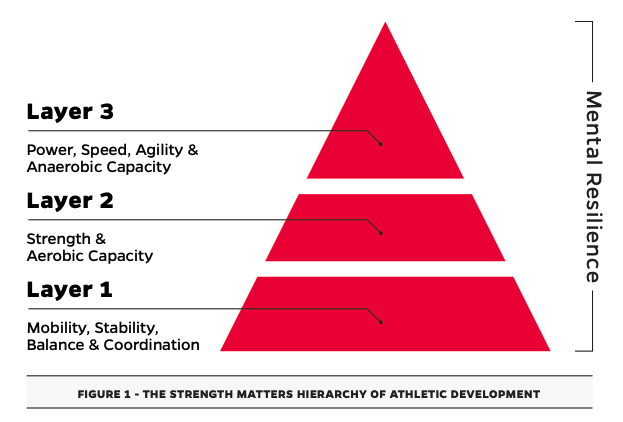Athleticism is formed by ten key components that make up balanced physical fitness, or what we refer to as complete athleticism. They are strength, speed, power, agility, anaerobic capacity, aerobic capacity, mobility, balance and coordination, mental resilience, and stability.
Table of Contents
One of the Most Embarrassing Moments of My Life
It was late September 2016. I was living in Melbourne, Australia, and it was the start of spring. The weather was turning and the days were getting longer. Little did I know at the time that this was the month that would change my whole life and business forever.
It was a Sunday morning, the sun was out, and my girlfriend at the time asked if I wanted to go for a run and then grab a coffee with her and her sister. I immediately said yes. I didn’t think anything of it. Running was something I always USED to do. But this time around, I hadn’t been for a run in a long time. In fact, a VERY long time. Six long years to be exact.
Running had always been a part of my life. Growing up in the mountains to Wales, playing soccer, rugby, and cricket, I didn’t know anything else. But this time, I was 34 years old. I hadn’t run for close to six years because I had gone deep into the traditional powerlifting, strength-only style workouts that my mentors, friends, peers, and colleagues were advocating:
“You need to keep getting stronger. Strength is the primary quality. Just focus on that,” they said. And I did. I really enjoyed it too, at the time. Until I left the house for that run…
We left the house and began to run. We headed down towards the beach. After the first minute, I could no longer hold a conversation with them. At minute two, I had to ask them to slow down so I could keep up. At minute three, I had to stop and walk.
It was at that point that I looked at two people who I knew very well. They were staring at me, wondering what the hell was going on. It was the look that said, “James, you’re a fitness professional. What is wrong with you?”
I was embarrassed. I was a trained professional but I couldn’t run for three minutes at a relatively moderate intensity. I told them to continue on without me and I’d see them at the coffee shop. It took me close to 90 minutes to get there. By the time I reached them, they had already finished their coffees.
It was the most demoralizing, embarrassing workout I had ever done, and it was a big wake up call for me. It made me see my training from a completely different perspective, and with a fresh set of eyes I immediately added a walk/run protocol into my weekly workload. I was determined never to feel like that ever again.

Another Embarrassing Moment of Discovery
A few weeks later, around mid to late October, another chance conversation led me to consider a return to cricket—a dream of mine that had been dashed due to a shoulder injury. I had been running for a few weeks and was feeling good. I thought, why not?
So, I went to the Tuesday night practice session, six years after I had last played, which coincidentally was also when I became serious about weight training and stopped running.
Looking back, I have no idea why I stopped playing cricket. It was such a big part of my life growing up. Thankfully, it is once again a big part of my life, but I know I’ll never be able to get that time back.
This will be one of my few regrets in life. For those of you unfamiliar with cricket, there is a long-standing rivalry between England and Australia. So, a “Pom”, as the Aussies like to call us Brits, turning up to play with them is kind of a big deal.
Once again, another moment of sheer embarrassment. It was like I had never played the game in my life. I couldn’t hit or catch the ball, and my bowling was all over the place. Much to the Aussies delight, the fast bowlers kept bowling short at me, and the ball kept hitting me. I woke up the next day black and blue from the bruises. I hurt all over and felt like I had been run over by a bus.
Demoralized and with my ego shot to pieces, I wasn’t deterred. In fact, it motivated me beyond belief, and I began to self-reflect and try to work out logically what was going on. Yes, I hadn’t played for a number of years so I was rusty. But, similar to the running experience, it was more than that. Much more.
It came down to the simple fact that I was no longer athletic. I thought I was when I trained, but I wasn’t.
I was strong but lacked any cardiovascular fitness. I was stiff and immobile. I wasn’t agile, and my balance and coordination was all over the place. I was decidedly unathletic. I needed to become athletic again. I began to research everything I could about how to turn an aging athlete back into a lean, mean fighting machine.
What Is Athleticism?
With a professional head firmly on my shoulders – not an emotional one – I began to look at this question from a logical standpoint. I needed to stay objective.
In order to become athletic, I needed to define athleticism and determine its key components and characteristics. It’s an extremely objective word that means different things to different people.
Initially, I turned to Google, and here’s what it came up with:
ath·let·i·cism noun. the physical qualities that are characteristic of athletes, such as strength, fitness, and agility. “What he lacks in stature, he more than makes up for with speed and athleticism.”
I’ll be honest. This didn’t really help much. Neither did the Merriam-Webster definition either.
There was nothing tangible I could use, nothing specific I could take away. After weeks of searching for an answer, I realized that I had to take matters into my own hands.
I presented to the Strength Matters team the seven components of complete athleticism, based on the original work of strength and conditioning expert Tudor Bompa.
And so, it began—the hours, weeks, and months of endless debate and discussion. We finally agreed on athleticism as having ten key components:
The Ten Components of Complete Athleticism
[Update Remark] In the original list of ten, we included cardiovascular capacity and endurance. After further experience and professional discussion, we decided it was no longer applicable to our system of training.
They were essentially the same thing. Aerobic capacity includes aerobic endurance. Anaerobic capacity is a very different kettle of fish and needs to be implemented very differently.
- Strength – the ability to create force
- Speed – the ability to minimize the time cycle of a given movement
- Power – the ability to create maximal force in minimal time
- Mental Resilience – the ability to push yourself out of your comfort zone
- Aerobic Capacity – the maximal amount of physiological work that an individual can do as measured by oxygen consumption
- Anaerobic Capacity – the maximal work performed during maximum-intensity short term physical effort
- Balance & Coordination – the ability to perform movements with precision and grace
- Agility – the ability to be nimble on your feet and move quickly from one movement pattern to another
- Stability – the ability to prevent movement in one part of the body while creating movement in another, thus protecting vulnerable areas
- Mobility – flexibility in motion, the range of motion through muscles and joints
Once we defined all ten components of athleticism, I thought we had put the entire debate to rest. I couldn’t have been more wrong. We had a further six months of debate and analysis because of a number of questions that needed to be answered.
Among them:
- Which component is the most important?
- How do we assess each of the ten components?
- What are the standards for each component?
- How do we address the ten components in workouts and training plans?
The list just grew and grew. And that’s how the Strength Matters Performance Pyramid was created. It was designed to provide order, logic, and structure to the ten components of complete athleticism.
The Strength Matters Performance Pyramid
After defining athleticism’s ten key components, we set about prioritizing them in order of need. But this had a number of limitations. We couldn’t order them from one to ten. It simply wouldn’t work that way. We had to group them together because they are all equally important.
We looked at this process through the lens of building a house. A house needs solid foundations before you can build the structure and before you can apply the finishing touches. We created three layers of fitness – Layer 1, Layer 2, and Layer 3 – and grouped certain components together.
We all agreed that we needed competency in key areas prior to others.

Balanced Fitness and Athleticism
Our vision of balanced fitness and athleticism began to take shape, and the Performance Pyramid was born.
As you can see, Layer 1 is the foundation of the system. We need a base level of mobility, stability, balance, and coordination first. It’s the foundation of the house. If we’re deficient in these areas, we believe progress will be slow and the risk of injury heightened.
Layer 2 is strength and aerobic capacity. Once we have our Layer 1 base, we start to build onto it with basic strength and aerobic capacity work. This becomes the springboard to make the leap to Layer 3.
Layer 3 is the sexy layer, and it’s advanced athlete territory. It’s the layer everyone wants to jump to. It includes power, speed, agility, and anaerobic work (HIIT). It’s also the layer that comes with the most risk.
If you’re deficient in any of the components of Layer 1 and Layer 2, it will show up here. This means that injury is more likely and peak athletic performance is hindered.
We decided collectively that mental resilience should be an overarching theme. It’s important for all parts of life and athletic endeavors. Such was its importance, it needed this overarching theme.
The Strength Matters Performance Pyramid became a tool for us to identify areas of weakness that needed to be addressed and morphed into a system that highlights the need to train our weaknesses.
It’s a system that leaves nothing to chance. A system to help athletes reach maximum physical potential. A system to help everyday people reduce the risk and likelihood of injury.
A system for people to know exactly what their weaknesses are and how they should train them. But more importantly, and selfishly, a system that would help this aging athlete over thirty reclaim his athletic lifestyle.
Hindsight Is a Wonderful Thing
I will always be thankful for that moment running in Melbourne. I will always be thankful for that day I went to cricket practice and got taken apart by the quick bowlers. They are probably the most pivotal points in my athletic career as an aging athlete.
Fast forward to today and I’m fitter, stronger, and more mobile than I ever was before. I’m back to feeling like an athlete again, but it wasn’t an easy path. It’s taken a lot of hard work, and trial and error. But it’s given me hope. It’s given me the ability to ski and snowboard, days and weeks in a row. It’s given me the ability to play cricket again at a competitive standard.
Before that run in Melbourne, I thought I was physically athletic. I foolishly didn’t consider that I possessed any weaknesses. I didn’t consider the key components that comprised balanced fitness and athleticism. I thought being strong, and strength training alone was the answer.
The worrying thing was that I had ignored the warning signs. I had just carried on, as usual, thinking these things were normal when lifting heavy weights:
- I couldn’t walk up a flight of stairs without getting out of breath.
- My body fat % continued to increase, and I didn’t care.
- Getting out of bed in the morning was becoming harder because I was becoming more stiff and rigid. I assumed this was old age.
- I had to see a chiropractor or physical therapist far more regularly, just to get rid of the pain.
The list could go on, but these are the things that I think back on now. What was I doing? I personally focused only on Layer 3 work. For six years, I did power work and not much else.
Speed, agility, and aerobic work were non-existent. Mobility, stability, and balance were an afterthought. And in terms of strength, I never went over 5 reps. Where was the muscular endurance and strength endurance work?
I wasn’t as elite as I thought I was. I came back to earth with a big thud. And I’m so glad I did, otherwise, I think my forties, fifties, and sixties would have been very sad times for my aging body.
Applying the Strength Matters Performance Pyramid
We’ve defined athleticism as having ten key components and introduced you to the Strength Matters Performance Pyramid for athlete development.
When it comes to our own athletic development, we need to remain objective and look at our fitness and athleticism through a clear, unbiased lens. We believe that this system allows us to remain objective at all times.
It gives us a framework to make better decisions about what we need to address first. It’s the framework we use every day in our coaching programs.
Our system allows us to focus on our weaknesses. It prioritizes the body as one single organism, and emphasizes the fact that you’re only as strong as your weakest link.
We can assure you that training according to this system will lift your performance to dizzying new heights in all the activities you value the most. Failure to acknowledge your weakest components will lead to life-changing injuries and everlasting weakness.
Heed my mistakes. Life as an everyday athlete with balanced athleticism is far more fun and enjoyable. Don’t make the same mistakes I made.
If you want to learn more, I’d recommend downloading the free e-book below to really dive in and learn our ultimate system of athleticism.
**Note. We’ve also written a version of this blog for our sister company Cricket Matters. We talk about the 10 Components of Fitness for Cricket

FAQ
What Is Athleticism?
Athleticism is formed by ten key components that make up balanced physical fitness, or what we refer to as complete athleticism. They are strength, speed, power, agility, anaerobic capacity, aerobic capacity, mobility, balance and coordination, mental resilience, and stability.
How Do You Train For Athleticism?
Training for athleticism involves improving ten key components: strength, speed, power, endurance, flexibility, mobility, agility, balance, coordination, and mental resilience. This can be achieved through a combination of weight lifting, cardio workouts, mobility drills, sport-specific training, and mental conditioning.
How Do You Define Athleticism?
Athleticism is formed by ten key components that make up complete athleticism. They are strength, speed, power, agility, anaerobic capacity, aerobic capacity, mobility, balance and coordination, mental resilience, and stability.
Is Athleticism Genetic?
Yes, genetics can influence athleticism to an extent, as it can predetermine physical traits such as height, muscle fiber type distribution, and VO2 max. However, training, mindset, and lifestyle also play crucial roles in shaping one’s athleticism.
What Makes Someone Athletic?
Someone is considered athletic when they possess a combination of strength, speed, endurance, agility, balance, and coordination. They typically excel in physical activities and sports, demonstrating a high level of fitness and skills in one or more areas. However, athleticism is not just physical abilities; it also involves mental resilience and strategic thinking.
What Is Considered Athleticism?
Athleticism is a combination of qualities that encompass physical strength, agility, endurance, speed, and coordination, along with mental attributes such as competitiveness and the ability to perform under pressure. It’s the ability to move the body efficiently and effectively in different sports and physical activities.
Is Athleticism a Skill or Talent?
Athleticism is a blend of both skill and talent. Some elements, like speed and agility, may be innate to an individual, qualifying as talent. However, skills such as endurance, coordination, and strength often require deliberate training and practice to develop and improve.
How Do You Determine Athleticism?
Determining athleticism often involves evaluating a person’s physical and mental attributes. This includes assessing their strength, speed, agility, endurance, coordination, flexibility, and mental fortitude. Performance in various sports activities, reaction time, and adaptability to different physical tasks can also be indicative of their level of athleticism.
What Are the Signs of High Athleticism?
Signs of high athleticism include quick reaction times, high endurance, exceptional speed, strong coordination, and excellent strength and flexibility. Highly athletic individuals also demonstrate a good understanding of movement mechanics, adapt quickly to new physical tasks, and show resilience and competitiveness in their respective sports or physical activities.


Nice one Royal! Great post!
Great article. Thank you!
Thanks, Julie! Glad you enjoyed it!
Another great article!
Very Impressed with your research and Article. Thank you for your guidance and the way you explained in layers.